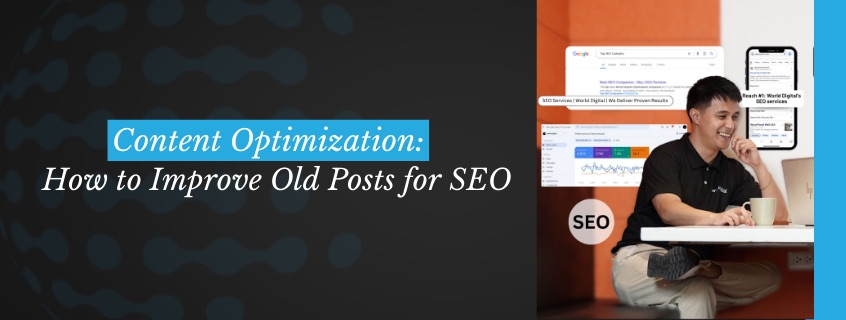Why Content Optimization Matters
The digital landscape is constantly evolving, and outdated content can hurt your search rankings, reduce engagement, and fail to attract new leads. Content optimization isn’t just about refreshing old posts—it’s about strategically improving them to drive traffic, enhance user experience, and boost conversions.
At World Digital, we specialize in helping businesses refine their content strategy to align with current SEO trends. By updating existing posts, we help brands stay relevant, competitive, and visible in search engine results.
Table of Contents
Key Benefits of Content Optimization:
- Boosts Search Engine Rankings – Search engines prioritize fresh, well-structured content.
- Enhances User Experience – Updated content is more relevant and engaging.
- Drives More Organic Traffic – Well-optimized posts attract more visitors.
- Increases Conversion Potential – Strategic updates improve lead generation.
- Strengthens Brand Authority – Updated content reinforces credibility and thought leadership.
Step-by-Step Guide to Optimizing Old Content
1. Conduct a Performance Audit
Start by identifying which content needs optimization. Use tools like Google Analytics, SEMrush, or Ahrefs to analyze:
- Traffic Trends – Identify declining page views.
- Bounce Rate – High bounce rates may indicate outdated or unengaging content.
- Keyword Rankings – Determine if targeted keywords are still relevant.
- Backlink Profile – Check if authoritative sites still link to your post.
Actionable Tip:
Prioritize high-performing posts that need minor tweaks for a rankings boost and low-traffic posts that have the potential for revival.
2. Update Keywords and Metadata
SEO trends change, and keyword relevance shifts over time. Ensure that your content reflects current search behaviors:
- Conduct Fresh Keyword Research – Use Google Keyword Planner or Ahrefs to identify trending terms.
- Optimize Title Tags & Meta Descriptions – Integrate updated primary keywords while maintaining click-worthy phrasing.
- Improve Readability – Naturally incorporate keywords into headings, subheadings, and body text.
Example:
Original Meta Description: “Learn about content optimization and why it matters for SEO.” Updated Meta Description: “Discover expert-backed content optimization strategies to boost rankings, drive traffic, and increase engagement.”
3. Improve Readability and Structure
A well-structured post is easier to scan, read, and digest.
- Break content into short paragraphs.
- Use H2 and H3 headers with relevant keywords.
- Add bullet points and numbered lists to highlight key takeaways.
- Improve flow with transition phrases that guide readers naturally.
4. Refresh Outdated Information
Statistics, industry trends, and references can quickly become outdated. Keep your content accurate by:
- Replacing old statistics with updated research.
- Linking to the latest authoritative sources.
- Fact-checking and removing outdated references.
Actionable Tip:
Use Google’s “Tools” feature in search results to filter data by the past year and find the most current insights.
5. Enhance Visuals and Multimedia Elements
Visual elements make content more engaging and improve retention.
- Include eye-catching infographics to summarize complex information.
- Add optimized images with alt text for SEO.
- Embed relevant videos for deeper engagement.
- Use comparison tables to present information concisely.
| Optimization Strategy | Benefits | Execution Tips |
|---|---|---|
| Keyword Refresh | Improves rankings | Identify new search trends and update headings and meta descriptions |
| Visual Enhancements | Increases engagement | Add infographics, videos, and high-quality images |
| Internal Linking | Enhances navigation | Link to relevant content on your site |
| Snippet Optimization | Boosts featured placements | Use clear, direct answers for common queries |
6. Strengthen Internal and External Linking
Internal and external links improve credibility and user navigation.
- Internal Links – Guide readers to related blog posts on your website.
- External Links – Reference high-authority sources to back up claims.
Example:
Instead of saying, “SEO is crucial for digital success,” say, “SEO strategies, such as those recommended by Google’s Search Central, help businesses enhance their online presence.”
7. Optimize for Featured Snippets
Google pulls structured content for featured snippets, which can significantly boost visibility.
- Use question-based subheadings (e.g., “What are the best ways to optimize content?”).
- Answer queries concisely within 50-60 words.
- Utilize bullet points and numbered lists for easy readability.
8. Promote and Repurpose Updated Content
Once your content is optimized, amplify its reach.
- Share on social media – Twitter, LinkedIn, and Facebook.
- Send email updates – Notify subscribers about refreshed content.
- Repurpose content – Turn blog posts into videos, podcasts, or infographics.
- Guest Post Collaborations – Cross-promote with industry partners.
The World Digital Content Optimization Process
- Content Audit & Analysis – Identifying underperforming content.
- Keyword Research & SEO Strategy – Discovering opportunities for improvement.
- Content Enhancement – Updating visuals, readability, and keyword integration.
- Technical SEO Optimization – Improving site speed, mobile-friendliness, and metadata.
- Publication & Promotion – Sharing across platforms and monitoring results.
Performance Tracking & Adjustments – Continuous refinement based on analytics.
Frequently Asked Questions
1. How often should I optimize old blog posts?
Review and refresh content at least every 6-12 months to keep it competitive.
2. Does updating old content improve SEO rankings?
Yes, optimized content signals relevance to search engines, which can improve rankings.
3. What tools can I use to track content performance?
Google Analytics, Ahrefs, SEMrush, and Moz are excellent for monitoring engagement and keyword rankings.
4. Should I change the publication date when updating content?
Only if significant changes are made. Otherwise, keep the original date but mention the update in the article.
5. How can I measure the success of content optimization?
Track organic traffic, engagement rates, conversion metrics, and keyword rankings.
By implementing these strategies, businesses can keep their content relevant, engaging, and search-friendly. At World Digital, we’re here to help maximize the potential of every post—keeping your brand ahead in the digital landscape.





